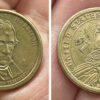The euro was supposedly on its way to achieving parity with the United States dollar by the end of 2017, according to analysts at Goldman Sachs Group Incorporated as reported in this article by James Ramage of The Wall Street Journal — but those analysts were off by approximately five years, as the two currencies were forecast to be at parity by as soon as next month in August of 2022…
Dollar and Euro Are At Parity July 12 2022
…but effective as of today, Tuesday, July 12, 2022, the dollar and the euro are at parity — meaning that one United States dollar will buy one euro; and one euro will buy one United States dollar as of the time this article was written — which is basically the lowest exchange rate ever between the two currencies.
The last time that the euro and the United States dollar were at parity was on January 1, 2002 — greater than 20 years ago — which is the year the euro entered circulation as a physical currency after spending three years as an “invisible” currency.
This means that citizens and legal residents of the United States can purchase more products and services for their money in Europe — but Europe has been experiencing similar inflation at 8.6 percent as what the United States is currently experiencing, with some countries in Europe experiencing an inflation rate as high as greater than eleven percent; so the prices for products and services may not be quite the bargain as one might expect…
…but that is still better than high inflation coupled with a poor currency exchange rate — which is what Europeans would experience when visiting the United States at the moment — and deals for those from the United States can still be found in Europe, thanks to the two currencies being at parity.
Also weighing down the economy in Europe is the uncertainty of the supply of energy as a result of the invasion of Ukraine by military forces of Russia — as well as fears of a recession — which could potentially cause the euro to be worth less than the United States dollar, which has never happened before in the history of the two currencies.
Final Boarding Call
I first noticed how close to parity is the exchange rate between the euro and the United States dollar when I wrote this article about how visiting Venice for the day will cost up to ten euros: “If you are hoping to visit Venice for the day to experience a ride in a gondola or take in Saint Mark’s Square or cross the Rialto Bridge sometime on or after Monday January 16, 2023, be prepared to reserve a spot on the day when you can visit and pay between €3.00 and €10.00 — or $3.13 and $10.43 in United States dollars — simply for the privilege of doing so.”
Keeping track of currencies can at times be quite difficult — especially if one has to deal with different currencies on multiple trips within the near future; and keeping track of exchange rates can drive one batty.
Even worse is attempting to find the best place to exchange those currencies. I tend to avoid airports; as local banks usually offer better rates. I spend a limited amount of time — as little as possible — shopping around to exchange currency for the best deal.
If you are fortunate enough to be a customer at a bank which does not charge fees for exchanging currency or withdrawing money out of its network, you can use your automated teller machine – or ATM — card to withdraw funds in local currency.
Another tact is to use your credit card to pay — but be wary of any currency exchange fees you might be charged. Again, you are fortunate if you use a credit card which does not charge such fees — usually somewhere between two and five percent of the amount charged.
An interesting way to acquire currency is to pay for a meal with your companions with your credit card and have them pay their shares to you in cash. No fees are usually involved in such transactions; and you get the bonus of earning credit — whether it is a cash back rebate or frequent travel loyalty program miles or points — as a result. This is especially useful if your dining companions have too much local currency just prior to their trips home and want to get rid of it quickly without paying fees — and especially if you are not leaving the country you are visiting right away. I have done this many times — most of them resulting in mutually beneficial circumstances.
I always acquire a slight bit more currency than I need, as I collect the smaller denominations and keep them as souvenirs. The extra bills and coins can also be a nice gift to someone who is interested in foreign currency.
For currency exchange rates, XE and Oanda are two of numerous tools you can use.
Please share your suggestions on how to keep up with currency exchange rates and get the most for your money. Thank you in advance.
Photograph ©2016 by Brian Cohen.

